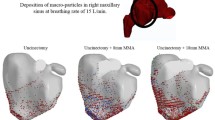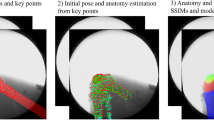Abstract
Purpose Manual segmentation of CT datasets for preoperative planning and intraoperative navigation is a time-consuming procedure. The purpose of this study was to develop an automated segmentation procedure for the facial skeleton based on a virtual anatomic atlas of the skull, to test its practicability, and to evaluate the accuracy of the segmented objects.
Materials and methods The atlas skull was created by manually segmenting an unaffected skull CT dataset. For automated segmentation of cases via IPlan cranial (BrainLAB, Germany), the atlas skull underwent projection, controlled deformation, and a facultative threshold segmentation within the individual datasets, of which 16 routine CT (13 pathologies, 3 without) were processed. The variations of the no-threshold versus threshold segmentation results compared to the original were determined. The clinical usability of the results was assessed in a multicentre evaluation.
Results Compared to the original dataset, the mean accuracy was \(\le 0.6\) mm for the threshold segmentation and 0.6–1.4 mm for the no-threshold segmentation. Comparing both methods together, the deviation was \(\le 0.2\) mm. An isolated no-threshold segmentation of the orbital cavity alone resulted in a mean accuracy of \(\le 0.6\) mm. With regard to clinical usability, the no-threshold method was clearly preferred, reaching modal scores of “good” to “moderate” in most areas. Limitations were seen in segmenting the TMJ, mandibular fractures, and thin bone in general.
Conclusion The feasibility of automated skull segmentation was demonstrated. The virtual anatomic atlas can improve the preprocessing of skull CT scans for computer assisted craniomaxillofacial surgery planning.










Similar content being viewed by others
References
Metzger MC, Schon R, Weyer N et al (2006) Computer-assisted extracorporeal orbital reconstruction after optic nerve decompression by removal of sphenoid bone. Ann Plast Surg 57:223–227
Zhou Z, Chen S, Tao D et al (2005) Medical image automatic adjusting window and segmentation. Sheng Wu Yi Xue Gong Cheng Xue Za Zhi. 22:331–334
Metzger MC, Hohlweg-Majert B, Schon R et al (2007) Verification of clinical precision after computer-aided reconstruction in craniomaxillofacial surgery. Oral Surg Oral Med Oral Pathol Oral Radiol Endod. 104:1–10
Rohlfing T, Brandt R, Menzel R et al (2004) Evaluation of atlas selection strategies for atlas-based image segmentation with application to confocal microscopy images of bee brains. Neuroimage 21:1428–1442
Schipper J, Klenzner T, Berlis A et al (2006) Objectivity of therapeutic results following skull base surgery using virtual model analysis. HNO 54:677–683
Pernozzoli A, Burghart C, Brief J et al (2000) Clinical evaluation of a highly accurate algorithm for CT bone contour segmentation. Stud Health Technol Inform 70:246–252
Miller RJ, Bier J (2006) Surgical navigation in oral implantology. Implant Dent 15:41–47
Cuadra MB, Pollo C, Bardera A et al (2004) Atlas-based segmentation of pathological MR brain images using a model of lesion growth. IEEE Trans Med Imaging. 23:1301–1314
Zachow S, Zilske M, Hege H-C (2012) 3D reconstruction of individual anatomy from medical image data: Segmentation and geometry processing. In: Konrad-Zuse-Zentrum für Informationstechnik Berlin (ZIB), eds. ZIB-Report 07–08. ZIB, Berlin, 2007: 7–41. Available at: http://vs24.kobv.de/opus4-zib/frontdoor/index/index/docId/1044. Accessed 7 Feb 2012
Wong RC, Tideman H, Merkx MA et al (2011) Review of biomechanical models used in studying the biomechanics of reconstructed mandibles. Int J Oral Maxillofac Surg 40:393–400
Heermann R, Schwab B, Issing PR et al (2001) Image-guided surgery of the anterior skull base. Acta Otolaryngol 121:973–978
Ganz SD (2008) Defining new paradigms for assessment of implant receptor sites. The use of CT/CBCT and interactive virtual treatment planning for congenitally missing lateral incisors. Compend Contin Educ Dent. 29:256–258 (260–252, 264–257; quiz 268, 278)
Plooij JM, Maal TJ, Haers P et al (2011) Digital three-dimensional image fusion processes for planning and evaluating orthodontics and orthognathic surgery. A systematic review. Int J Oral Maxillofac Surg 40:341–352
Eufinger H (1994) Individual augmentation of the atrophic mandible based on CAD/CAM-manipulated computed tomography data-in vitro results. Int J Oral Maxillofac Surg 23:399–402
Eufinger H, Pack M, Terheyden H et al (1999) Experimental computer-assisted alloplastic sandwich augmentation of the atrophic mandible. J Oral Maxillofac Surg. 57:1436–1440 (discussion 1440–1431)
Zizelmann C, Schramm A, Schon R et al (2005) Computer assisted methods in reconstructive and function-preserving orbital surgery. New capabilities of computer assisted preoperative surgical planning (CAPP) and computer assisted surgery (CAS). HNO 53:428–438
Nowinski WL (2001) Modified Talairach landmarks. Acta Neurochir (Wien) 143:1045–1057
Liu J, Huang S, Wojciech A et al (2010) Automatic model-guided segmentation of the human brain ventricular system from CT images. Acad Radiol 17:718–726
Deuflhard P (2008) Mehr Mathematik wagen in der Medizin. ZIB, Berlin
Flores RL, Deluccia N, Grayson BH et al (2010) Creating a virtual surgical atlas of craniofacial procedures: part I. Three-dimensional digital models of craniofacial deformities. Plast Reconstr Surg 126:2084–2092
Flores RL, Deluccia N, Oliker A et al (2010) Creating a virtual surgical atlas of craniofacial procedures: Part II. Surgical animations. Plast Reconstr Surg 126:2093–2101
Conflict of interest
None.
Author information
Authors and Affiliations
Corresponding author
Rights and permissions
About this article
Cite this article
Metzger, M.C., Bittermann, G., Dannenberg, L. et al. Design and development of a virtual anatomic atlas of the human skull for automatic segmentation in computer-assisted surgery, preoperative planning, and navigation. Int J CARS 8, 691–702 (2013). https://doi.org/10.1007/s11548-013-0818-6
Received:
Accepted:
Published:
Issue Date:
DOI: https://doi.org/10.1007/s11548-013-0818-6




